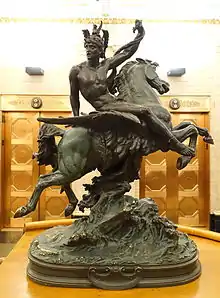Pierre-Eugène-Emile Hébert
Pierre-Eugène-Émile Hébert (October 12 or 20, 1823 – 1893) was a French sculptor. As the son of sculptor Pierre Hébert, he studied both with his father and with Jean-Jacques Feuchère (1807–1852). Émile Hébert participated in the Salon de Paris and the Exposition Universelle (1855), created the allegorical statues La Comédie and Le Drame for the vaudeville theatre in Paris, and was awarded a Second Class Medal in 1872. Émile Hébert was one of the few sculptors to work with the renowned bronze fondeur Georges Servant, and their artistic collaboration resulted in pieces of the Neo-Grecian and Egyptian Revival style.[1]

Bellerophon by Émile Hébert, Chicago, Palmer House Hilton Hotel.
_-_Pierre-Eugene-Emile_Hebert_1860_-_NG_of_Arts_Wash_DC.jpg.webp)
Amazon Preparing for Battle, 1860, Washington, D.C., National Gallery of Art.
Selected works
Wikimedia Commons has media related to Pierre-Eugène-Emile Hébert.
- Jeune fille sauvant une abeille, 1855
- Méphistophélès, bronze, Stanford University, 1855
- L'Amour suppliant, 1859
- Amazone se préparant à la bataille, bronze, National Gallery of Art, Washington, 1860
- Et toujours !! Et jamais !!, Collection Joey and Toby Tanenbaum, Toronto, Canada, 1863
- Bacchus, 1866
- La Pologne, medallion, 1867
- M. Servant, bust, 1867
- Bas-reliefs du monument à L'Amiral Duperré, La Rochelle, 1868
- Œdipe, 1869
- L'Oracle, marble bas-relief, 1872
- Bellérophon vainqueur de la Chimère, 1874
- Sémiramis, reine d'Assyrie, bust, 1874
- Alexandre Tessier, propagateur du moutons mérinos, bronze bust, 1876
- Buste de Balzac, High Museum of Art, Atlanta, 1877
- Table de style néo-grec, Musée d'Orsay, Paris, c. 1878
- Rabelais, Chinon, 1882
- L'Oracle, bas-relief, 1893
External links
- Pierre-Eugène-Emile Hébert in American public collections, on the French Sculpture Census website
- Pierre-Eugène-Emile Hébert, Dictionnaire général de biographie contemporaine française et étrangère, Adolphe Louis Émile Bitard, M. Dreyfous, page 642, 1878.
- National Gallery of Art
This article is issued from Wikipedia. The text is licensed under Creative Commons - Attribution - Sharealike. Additional terms may apply for the media files.